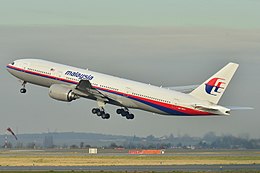Malaysia Airlines MH370

9M-MRO, the aircraft that disappeared, photographed in 2011
| |
| Occurrence summary | |
|---|---|
| Date | 8 March 2014 |
| Summary | Cause Unknown, search halted since 17 January 2017 |
| Site | Southern Indian Ocean (presumed) |
| Passengers | 227 |
| Crew | 12 |
| Fatalities | 239 (all) |
| Survivors | 0 |
| Aircraft type | Boeing 777-200ER |
| Operator | Malaysia Airlines |
| Registration | 9M-MRO |
| Flight origin | Kuala Lumpur International Airport, Kuala Lumpur, Malaysia |
| Destination | Beijing Capital International Airport, Beijing, China |
Malaysia Airlines Flight 370 (MH370/MAS370) was a scheduled international passenger flight that disappeared on 8 March 2014 while flying from Kuala Lumpur International Airport, Malaysia, to Beijing Capital International Airport in China. The aircraft, a Boeing 777-200ER operated by Malaysia Airlines, last made voice contact with air traffic control at 01:19 MYT, 8 March (17:19 UTC, 7 March) when it was over the South China Sea, less than an hour after takeoff. The aircraft disappeared from air traffic controllers' radar screens at 01:22 MYT. Malaysian military radar continued to track the aircraft as it deviated westwards from its planned flight path and crossed the Malay Peninsula. It left the range of Malaysian military radar at 02:22 while over the Andaman Sea, 200 nautical miles (370 km) north-west of Penang in north-western Malaysia. The aircraft was carrying 12 Malaysian crew members and 227 passengers from 15 nations.
The multinational search effort for the aircraft is the largest and most expensive in aviation history. The search began in the Gulf of Thailand and the South China Sea, where the aircraft's signal was last detected on secondary surveillance radar, and was soon extended to the Strait of Malacca and Andaman Sea. Analysis of satellite communications between the aircraft and Inmarsat's satellite communications network concluded that the flight continued until at least 08:19 and flew south into the southern Indian Ocean, although the precise location cannot be determined. Australia took charge of the search on 17 March when the search moved to the southern Indian Ocean. On 24 March, the Malaysian government noted that the final location determined by the satellite communication is far from any possible landing sites, and concluded that "Flight MH370 ended in the southern Indian Ocean." From October 2014 through January 2017, a comprehensive survey of 120,000 km2 (46,000 sq mi) of sea floor about 1,800 km (1,100 mi) south-west of Perth, Western Australia, yielded no evidence of the aircraft. Several pieces of marine debris found on the coast of Africa and on Indian Ocean islands off the coast of Africa, the first discovered on 29 July 2015 on Réunion, have been confirmed as pieces of Flight 370. However, the bulk of the aircraft has still not been located, prompting many theories about its disappearance.
Malaysia established the Joint Investigation Team (JIT) to investigate the incident, working with foreign aviation authorities and experts. Neither the crew nor the aircraft's communication systems relayed a distress signal, indications of bad weather, or technical problems before the aircraft vanished. Two passengers travelling on stolen passports were investigated, but eliminated as suspects. Malaysian police have identified the captain as the prime suspect if human intervention was the cause of the disappearance, after clearing all others on the flight of suspicious motives. Power was lost to the aircraft's satellite data unit (SDU) at some point between 01:07 and 02:03; the SDU logged onto Inmarsat's satellite communication network at 02:25—three minutes after the aircraft left the range of radar. Based on analysis of the satellite communications, the aircraft turned south after passing north of Sumatra and the flight continued for five hours with little deviation in its track, ending when its fuel was exhausted.
With the presumed loss of all on board, Flight 370 is the second deadliest incident involving a Boeing 777 and the second deadliest incident in Malaysia Airlines' history, behind Flight 17 in both categories. Malaysia Airlines was struggling financially, a problem that was exacerbated by a decline in ticket sales after the disappearance of Flight 370 and the crash of Flight 17; the airline was re-nationalised by the end of 2014. The Malaysian government received significant criticism, especially from China, for failing to disclose information promptly during the early weeks of the search. Flight 370's disappearance brought to public attention the limits of aircraft tracking and flight recorders, including several issues raised four years earlier—but never mandated—following the loss of Air France Flight 447. In response to Flight 370's disappearance, the International Civil Aviation Organization (ICAO) adopted new standards for aircraft position reporting over open ocean, extended recording time for cockpit voice recorders, and, from 2020, will require new aircraft designs to have a means to recover the flight recorders, or the information they contain, before the recorders sink below water.
Related Topic: Unsolved Plane Mysteries (Plane Disappearances)
If u liked it..do..Like..Share.
Follow me on:
G+ Scroll down this page.
Facebook Info_6
YouTube Subscribe
Thank You ✌






